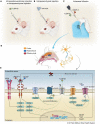Neurotrophin Crosstalk in the Etiology and Treatment of Neuropsychiatric and Neurodegenerative Disease
- PMID: 35909451
- PMCID: PMC9335126
- DOI: 10.3389/fnmol.2022.932497
Neurotrophin Crosstalk in the Etiology and Treatment of Neuropsychiatric and Neurodegenerative Disease
Abstract
This article reviews the current progress in our understanding of the mechanisms by which growth factors, including brain-derived neurotrophic factor (BDNF) and vascular endothelial growth factor (VEGF), and select neurotrophin-regulated gene products, such as VGF (non-acronymic) and VGF-derived neuropeptides, function in the central nervous system (CNS) to modulate neuropsychiatric and neurodegenerative disorders, with a discussion of the possible therapeutic applications of these growth factors to major depressive disorder (MDD) and Alzheimer's disease (AD). BDNF and VEGF levels are generally decreased regionally in the brains of MDD subjects and in preclinical animal models of depression, changes that are associated with neuronal atrophy and reduced neurogenesis, and are reversed by conventional monoaminergic and novel ketamine-like antidepressants. Downstream of neurotrophins and their receptors, VGF was identified as a nerve growth factor (NGF)- and BDNF-inducible secreted protein and neuropeptide precursor that is produced and trafficked throughout the CNS, where its expression is greatly influenced by neuronal activity and exercise, and where several VGF-derived peptides modulate neuronal activity, function, proliferation, differentiation, and survival. Moreover, levels of VGF are reduced in the CSF of AD subjects, where it has been repetitively identified as a disease biomarker, and in the hippocampi of subjects with MDD, suggesting possible shared mechanisms by which reduced levels of VGF and other proteins that are similarly regulated by neurotrophin signaling pathways contribute to and potentially drive the pathogenesis and progression of co-morbid neuropsychiatric and neurodegenerative disorders, particularly MDD and AD, opening possible therapeutic windows.
Keywords: ADNP (activity dependent neuroprotective protein); Alzheimer’s disease; BDNF (brain derived neurotrophic factor); MDD (major depressive disorder); TLQP-62; TrkB; VEGF – vascular endothelial growth factor; VGF.
Copyright © 2022 Joshi and Salton.
Conflict of interest statement
The authors declare that the research was conducted in the absence of any commercial or financial relationships that could be construed as a potential conflict of interest.
Figures


Similar articles
-
VGF and Its C-Terminal Peptide TLQP-62 Regulate Memory Formation in Hippocampus via a BDNF-TrkB-Dependent Mechanism.J Neurosci. 2015 Jul 15;35(28):10343-56. doi: 10.1523/JNEUROSCI.0584-15.2015. J Neurosci. 2015. PMID: 26180209 Free PMC article.
-
Role of a VGF/BDNF/TrkB Autoregulatory Feedback Loop in Rapid-Acting Antidepressant Efficacy.J Mol Neurosci. 2019 Jul;68(3):504-509. doi: 10.1007/s12031-018-1124-0. Epub 2018 Jul 18. J Mol Neurosci. 2019. PMID: 30022437 Free PMC article. Review.
-
VGF as a biomarker and therapeutic target in neurodegenerative and psychiatric diseases.Brain Commun. 2021 Oct 27;3(4):fcab261. doi: 10.1093/braincomms/fcab261. eCollection 2021. Brain Commun. 2021. PMID: 34778762 Free PMC article. Review.
-
Human VGF-Derived Antidepressant Neuropeptide TLQP62 Promotes SH-SY5Y Neurite Outgrowth.J Mol Neurosci. 2020 Aug;70(8):1293-1302. doi: 10.1007/s12031-020-01541-8. Epub 2020 May 26. J Mol Neurosci. 2020. PMID: 32458204
-
Neuropeptide VGF C-Terminal Peptide TLQP-62 Alleviates Lipopolysaccharide-Induced Memory Deficits and Anxiety-like and Depression-like Behaviors in Mice: The Role of BDNF/TrkB Signaling.ACS Chem Neurosci. 2017 Sep 20;8(9):2005-2018. doi: 10.1021/acschemneuro.7b00154. Epub 2017 Jun 21. ACS Chem Neurosci. 2017. PMID: 28594546
Cited by
-
Investigating Neuroplasticity Changes Reflected by BDNF Levels in Astrocyte-Derived Extracellular Vesicles in Patients with Depression.Int J Nanomedicine. 2024 Sep 2;19:8971-8985. doi: 10.2147/IJN.S477482. eCollection 2024. Int J Nanomedicine. 2024. PMID: 39246428 Free PMC article.
-
Potential Plausible Role of Stem Cell for Treating Depressive Disorder: a Retrospective Review.Mol Neurobiol. 2024 Jul;61(7):4454-4472. doi: 10.1007/s12035-023-03843-5. Epub 2023 Dec 14. Mol Neurobiol. 2024. PMID: 38097915 Review.
-
Natural antisense transcripts as drug targets.Front Mol Biosci. 2022 Sep 27;9:978375. doi: 10.3389/fmolb.2022.978375. eCollection 2022. Front Mol Biosci. 2022. PMID: 36250017 Free PMC article. Review.
-
Involvement of the VGF/BDNF axis in the neuropathology of Alzheimer's disease and its potential role in diagnosis and treatment.Rev Neurosci. 2024 Nov 19;36(3):267-278. doi: 10.1515/revneuro-2024-0110. Print 2025 Apr 28. Rev Neurosci. 2024. PMID: 39566031 Review.
-
Late-onset major depressive disorder: exploring the therapeutic potential of enhancing cerebral brain-derived neurotrophic factor expression through targeted microRNA delivery.Transl Psychiatry. 2024 Sep 3;14(1):352. doi: 10.1038/s41398-024-02935-7. Transl Psychiatry. 2024. PMID: 39227372 Free PMC article. Review.
References
-
- Asano T., Koizumi S., Takagi A., Hatori T., Kuwabara K., Fujino O., et al. (2011). Identification of a novel biomarker candidate, a 4.8-kDa peptide fragment from a neurosecretory protein VGF precursor, by proteomic analysis of cerebrospinal fluid from children with acute encephalopathy using SELDI-TOF-MS. BMC Neurol. 11:101. 10.1186/1471-2377-11-101 - DOI - PMC - PubMed
Publication types
LinkOut - more resources
Full Text Sources

